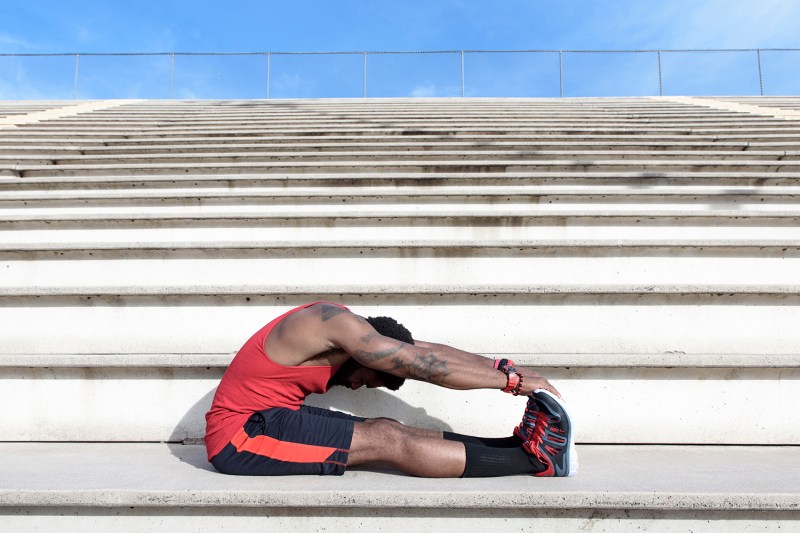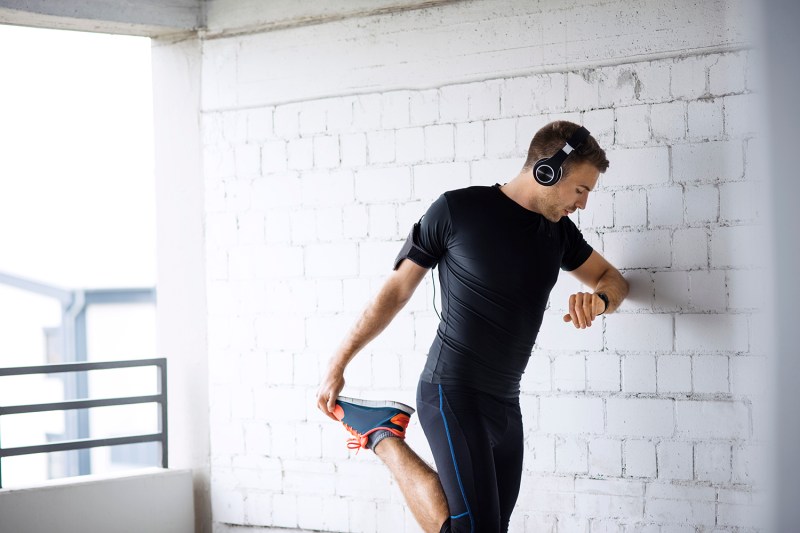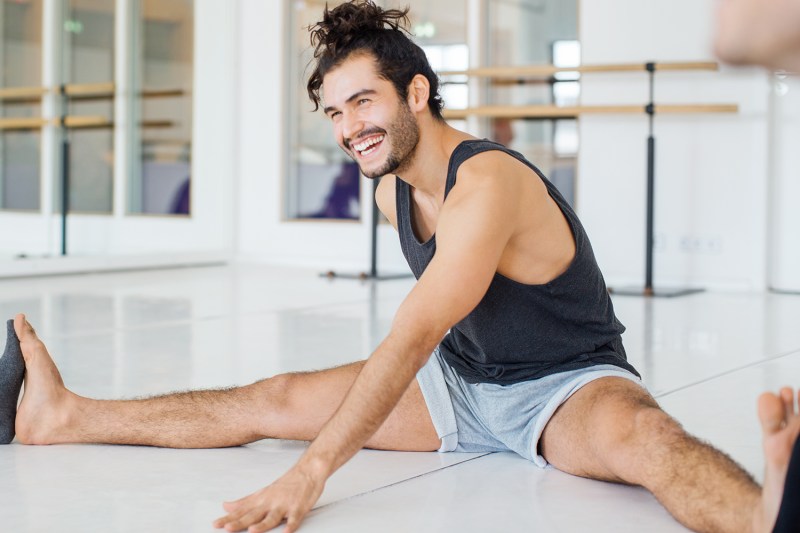
Even if you’re aware that Olympic athletes and elite bodybuilders count stretching as an integral part of their warm-up routine, you still find yourself skipping it before a workout. Why? Because, unlike strength training and a full-body workout, you don’t see results from stretching. But if you’re doing it right, you’re not supposed to.
We talked with fitness expert Will Torres of New York City’s Will Space, an elite movement studio, to help us understand the hidden benefits of stretching and what makes it so important. “We are constantly researching fitness methods,” Torres said. “But we’re finding that no matter how fit our clients were, they were still getting injured from time to time. They’d tweak this or that, and we’d send them to a physical therapist.”
Every year around the holidays, Torres would get a nice bag of oranges from the therapist for all those referrals. Torres developed his current training method and “now I don’t get oranges anymore.”

Why you should be stretching
Torres found that people have injuries like golf or tennis elbow but don’t even play those sports. Clients would resist stretching or rely on the same stretches they’ve been doing ever since high school, like grabbing one foot behind you to stretch the hamstrings or pushing an arm held at a right angle against a door frame. Neither is particularly effective, and they do nothing to improve flexibility.
“Stretching has all sorts of connotations for men … they usually think it has to be about yoga. We actually don’t recommend yoga. It doesn’t provide active flexibility. For guys especially, you’re also at the mercy of an instructor who, more often than not, is focused on women and women’s bodies,” Torres explained. “We encourage a direct, focused strategy to open up muscles, emphasizing active flexibility. Every strength movement should be complemented with a counter stretch. Stretching should also be done between sets to allow more blood flow, not left for the end. What’s most important is that stretching strengthens connective tissue, cutting down on the strain and tear of tendons. It’s about education; informing and inspiring movement. There are benefits to a properly executed handstand that you’ll never get from an overhead barbell press where you don’t straighten your arms.”
Torres pointed out that many of us put in time at the gym — growing bigger, getting more fit — but in the end, we have no flexibility. How do we achieve that?
“We encourage a direct, focused strategy to open up muscles, emphasizing active flexibility. Every strength movement should be complemented with a counter stretch.”
“First, we take the weight away. Master your body first, then build as we open the body up. Cut out some of the repetitive and insert the relevant,” Torres said.
This method requires more time and patience to start. Torres suggested adding three to five repetitions of each counter-stretch to your routine. Then holding each for 90 to 120 seconds to make an impact. “The pain you’ll start to feel about 30 seconds into a stretch triggers our fight or flight instincts. The job here is to wait. Once you’ve gotten used to the stretch, then we may add weight or assist you with pushing further after you’ve gotten used to it,” he explained. Torres compared it to football players who take ballet or Pilates classes to add flexibility.
Torres suggested stretching every day. With perseverance, these stretches will make muscles longer, more mobile, and perform better.
One of Torres’s former coaches, Jorge Reyes, was a bodybuilder before joining the Will Space team. “I was in great shape, but my chest was so tight it pulled my shoulders forward so I was curled up,” Reyes said. “I knew all these other guys who were jacked, but couldn’t even bend over to pick up a pencil.”
The most commonly targeted areas for men are their shoulders, biceps, hips, hamstrings, and thighs, according to Torres. He recommended some specific stretches (see below) to work into your routine. The best stretches to know are the ones you’ll do regularly, preferably every day, so stay committed and push through the pain.
To really go deeper into the program, however, you will need to get some one-on-one time in with a coach. Torres also experimented with an open-class forum with the GymFit site, which offers guidance in bodyweight training, carrying an endorsement from Four Hour success guru Tim Ferriss.
Before we get into the stretches, a personal note from the author: I had the opportunity to try a couple of introductory workouts to Torres’ method, and it was a lot more challenging than I expected. I’m in pretty decent shape for my age and found that, although my strength certainly helped, I was absolutely working up a sweat before long from a workout that was supposed to be “just stretching.”
It was also pretty humbling to attempt some of the stretches in a mirror and — although I’ve never claimed to be much of a dancer — realize how much more graceful a body can look once its muscles are being pulled in the right direction. If I have one piece of advice for anybody considering this, remember to actively engage muscles while stretching. Honestly, I’d also recommend working with a certified trainer on any of these to start, too. Watching videos is one thing, but a trainer can keep an eye out for problem areas you may not recognize.
Best stretching exercises
Table rock
Recommended post-bench press, this stretch is basically the opposite movement. Form a table with your body, where your chest and belly are on the top of the table. Your bent knees form one set of legs; your arms, extended down from the shoulder, form the others. Your hands are flat, pointing away “north” of your head. Rock forward through the knees while engaging the traps, abs, and glutes.

Straddle-seated good morning
Stretch legs out in front of you in a wide V-shape. Bow to the ground. It’s that simple. But take it easy on yourself. Feel free to sit on a medicine ball, block, or folded towel until you build flexibility. Hip stretches like this one will help you with mobility and agility in strength training, as well as cardio exercises like running.
German Hang (Skin the Cat)
Relieving pectoral and bicep tension, the German Hang creates more flexibility and strength in the shoulder region. With your back to a stall bar (the piece of equipment that is attached to the wall at your gym that looks like a wide ladder), reach behind you with both hands and grasp a bar, hands wider apart than shoulders. Knees and feet are together. Subtly and slowly bend the knees. (This video calls the exercise Skin the Cat. The German Hang is typically performed on rings. Let’s work our way up to that later.)

Frog pose
If you’re looking for stretches for lower back pain, this is the one you need to know. Get on your knees, then spread them wide. Keep your shins flat to the ground and drop your elbows in front of you. You can do various arm movements, but Torres recommends bringing your hands together to form a V, then subtly arching the back while engaging pecs, arms, abs, and glutes. Back stretches feel particularly great after a long day of sitting at work.
Standing Achilles
Calf stretches are especially important for runners and cyclists. With the toes of one foot resting on top of a yoga block or a dumbbell and your heel on the floor, keep the opposite leg behind you and touch the floor with your toes. Keep the front leg in a straight line while engaging the quads. Hold for 30 seconds. Use yoga blocks to help with your form if you can’t reach the floor while keeping that leg straight. (Author’s note: This is where the “fight or flight” instinct really started to kick in.)

Can you use a foam roller instead of stretching after a workout?
While both foam rolling and stretching offer benefits for recovery, they don’t directly replace each other. Here’s why:
Foam rolling
- Targets fascia: It primarily focuses on releasing tension in the fascia, a connective tissue surrounding muscles and organs. This can help with muscle soreness and potentially improve blood flow.
- Not for lengthening muscles: It doesn’t directly contribute to increasing flexibility or range of motion like stretching does.
Stretching
- Lengthens muscles: Stretching aims to elongate muscle fibers, improving flexibility and potentially reducing stiffness.
- Doesn’t directly address fascia: Stretching won’t necessarily target and release muscle knots or tension in the fascia like foam rolling can.
Therefore, using a foam roller instead of stretching after a workout might not be the best choice. They address different aspects of recovery, so ideally, incorporating both could be the most beneficial.



